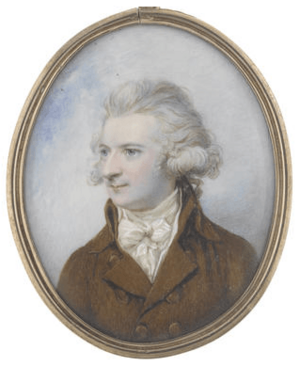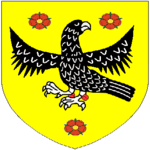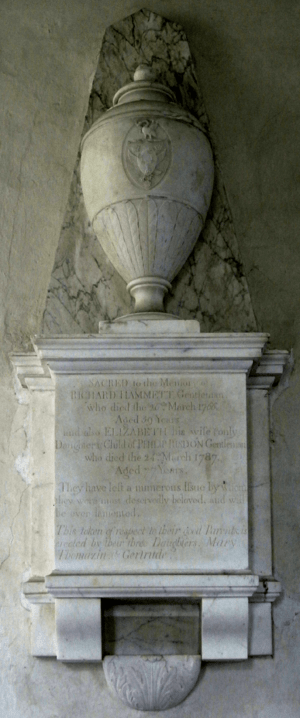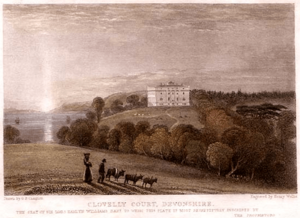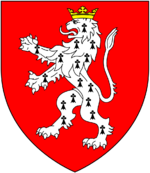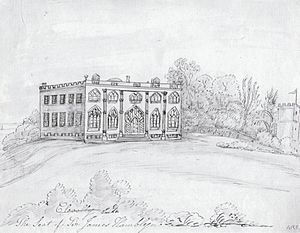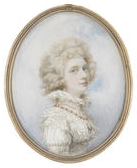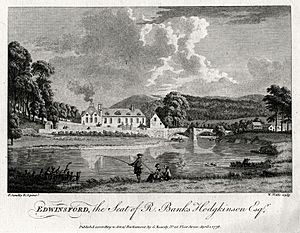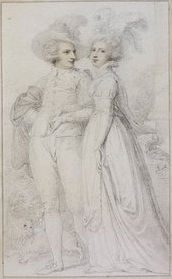Sir James Hamlyn, 1st Baronet facts for kids
Sir James Hamlyn, 1st Baronet (born James Hammet), lived from 1735 to 1811. He was an important person from Clovelly Court in Devon, England, and Edwinsford in Carmarthenshire, Wales. He served as a Member of Parliament (MP) for Carmarthen from 1793 to 1802. He was also the Sheriff of Devon in 1767–68. In 1795, he was given the special title of Baronet. Sir James became very wealthy because he inherited a large estate from his great-uncle. He also married a rich woman from Wales.
Contents
Early Life and Family
James Hammet was born in October 1735. He was the oldest son of Richard Hammett (1707–1766) and Elizabeth Risdon (1710–1787). His mother, Elizabeth, was the only child of Philip Risdon. You can still see a monument for his parents in Holy Trinity Church, near Clovelly.
The monument says: "This is to remember Richard Hammett, who died on March 26, 1766, at 59 years old. Also, Elizabeth his wife, who died on March 24, 1787, at 77 years old. They had many children who loved them very much. Their three daughters, Mary, Thomazin, and Gertrude, put up this monument to honor their good parents."
The monument also shows the Hammett family crest. It has a falcon and three red roses. It also shows the Risdon family crest, which has three black "birding bolts" (like arrows).
How He Became Wealthy
In 1759, James Hammet inherited the important estate of Clovelly. This happened after his great-uncle, Zachary Hamlyn (1677–1759), passed away. Zachary Hamlyn was a lawyer and had bought Clovelly Court in 1738. He made it his home.
The Hamlyn family name is very old. It is thought to come from a person named Hamelin who lived around 1086. He owned land after William the Conqueror came to England.
When James Hammet inherited Clovelly, there was a special rule. In 1760, he had to change his last name to Hamlyn. He also had to use the Hamlyn family crest. This crest shows a red shield with a white lion that has a gold crown.
A writer named John Swete visited Clovelly in 1797. He wrote that Sir James's brother, Mr. Hamet, was a clergyman in Clovelly. He had built a very nice house there.
His Important Jobs
Sir James Hamlyn studied law in 1750. He held several important positions:
- He was the Lord Lieutenant of Carmarthenshire. This was a high-ranking official role.
- He served as a Member of Parliament (MP) for Carmarthen from 1793 to 1802. An MP helps make laws for the country.
- He was the Sheriff of Devon from 1767 to 1768. A sheriff was in charge of law and order in the county.
- On July 7, 1795, he was given the title of Baronet. This is a special hereditary title, like a knight, but it can be passed down in the family.
Rebuilding Clovelly Court
In 1789, a fire destroyed Sir James's home, Clovelly Court. He decided to rebuild it in a popular style called Georgian-Gothic. This style mixed old Gothic castle looks with newer Georgian designs.
John Swete, the writer, visited Clovelly in 1797. He wrote about the new house: "The front of the house looked very Gothic. It had beautiful stone carvings. But when I walked around to the other sides, the Gothic style was gone! It looked like a modern building. I was surprised by this sudden change."
Swete thought the house didn't look like a complete, matching design. However, he loved the natural beauty of the area around Clovelly.
Marriage and Children
On June 11, 1762, Sir James married Arabella Williams. She was the daughter of Thomas Williams, who owned a lot of land in Carmarthenshire, Wales. Arabella later inherited a huge fortune.
John Swete wrote that Sir James "married a Miss Williams who had a vast fortune." He also noted that Sir James spent most of his time at his home in Wales after marrying Arabella.
Arabella's family, the Williams family, was very old and important in Wales. Arabella inherited the Edwinsford estate because her older sister, Bridget Williams, died without children.
Sir James and Arabella had three children:
- Sir James Hamlyn-Williams, 2nd Baronet (1765–1829). He added "Williams" to his name in 1798.
- Zachary Hamlyn, who died when he was young.
- Arabella Hamlyn (died 1805). She married Ambrose St John, who was also a Member of Parliament. She had two sons and five daughters.
Death and Burial
Sir James Hamlyn died on May 28, 1811. He was buried in All Saints Church in Clovelly, right next to Clovelly Court. There are monuments in the church for both him and his wife, Arabella. They were made by T. King & Sons of Bath.


